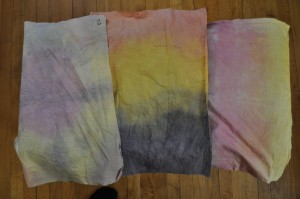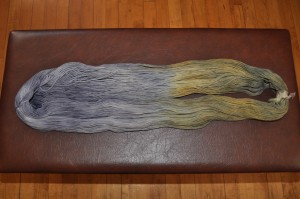Thu 11 Mar 2010
I have been pretty successful at avoiding stash enhancement lately. There’s no particular reason, except that I have a lot of yarn, haven’t been doing as much knitting, and just don’t really need more.
But a couple of weekends ago, I did need more.
I bought one skein of bare (undyed) merino to round out my collection of yarn for dyeing.
Donna Brown was in Madison, and gave two full-day workshops on natural dyeing. I couldn’t make it to both (silly things like having a job got in the way…), but I did go to the weekend one, and it was a lot of fun.
First, we started out with silk and cotton fabric samplers:
And then, I played with yarn. This one is dip-dyed in Logwood, Brazilwood, and madder (left to right).
This is my favorite. It was also dip-dyed, in osage orange, brazilwood, and logwood. (Turns out that orange and purple make green…go figure.)
More logwood and osage orange. I wasn’t sure if I loved or hated this one when it came out of the dye bath. Turns out I love it.
Then, I tried some “tie-dyeing.” I had two skeins of laceweight, and I wanted a semi-solid color. I took the yarn, wound it tightly into skeins, and put it in the dye pot. After a few minutes, the outside of the skein was dyed, and the inside was still white. Then, I opened the skeins, and dyed them again for a very short time.
Logwood (again…can you tell I liked this one?)
And Lac.
I also tried some handpainting. This is the only skein I am disappointed with. The others were all immersion-dyed, and all took the dye really, really well. This one was a different brand (that one skein that I bought to add to the collection), and I steamed it to set the dye. I either didn’t do the steaming well, or the yarn was resistant to the mordant/dye for some unknown reason. So, unfortunately, these colors leak like crazy, and have faded significantly in the wash. The dyes, for the record, are Logwood, Fustic, Madder, and Pomegranate.
I’m not sure what I’ll do with this. I might try remordanting it and overdyeing, or I might leave it as is and let it bleed.
Since all but one of the skeins have been in the stash for about a year, this does not count as stash enhancement. More like stash conversion. But the end result is the same…I now have a lot more yarn to use!
I did notice that the yarn feels a tiny bit rougher after dyeing than it did at the beginning, and I think it leaves a small residue on my hands. I think this probably means that it just needs another long soak to finish washing out the alum mordant….it feels a little like your hair after a day in the ocean or a chlorine pool – a ,little dry, perhaps, but my guess is that another wash would take care of that.
Overall, I really liked the natural dyeing. We used natural dye extracts rather than the raw materials (the extracts come as fine powder, so it’s really just like working with synthetic acid dyes). They were simple and easy to use, with no stewing and steeping before the dyeing can begin. The only extra step was the mordant, and that was really no different than the usual “presoak” before dyeing.
I liked the fact that the dye bath actually exhausts and the water runs clear before you throw it down the sink. As someone that thinks daily about which chemicals are and aren’t safe to wash down the drain, I really, really hate throwing dye molecules down the sink. I can’t imagine what kinds of fines we’d get slapped with for doing that same thing in my lab across town, so I always cringe when I do it at home. Yes, I know that it’s about the scale of the waste – there’s a difference between telling a chemical lab that it’s ok to throw bleach or acetone (nail polish remover) down the drain and using it for household purposes – and the chemical dyes are reasonably safe, but still. I liked the fact that the water I threw out was clear.
I’m not sure where I stand on the “safety” of natural dyeing vs. dyeing with synthetic chemicals. I appreciate the tradition, I think it’s fascinating to get dye from everyday things, but I’m not sure that natural dyes are any safer. Nature produces the best poisons, so it’s hard to argue that natural is inherently safe. And, as a chemist, I recognize that many (if not most) of the synthetic dyes are either the same chemicals or closely related to their natural cousins. There’s a good reason for this…nature generally does a much better job of thinking up cool and complicated molecules than people do, and it’s a lot easier to copy and riff off of a natural product than it is to invent something entirely new. So, ambivalent about the safety thing.
On the whole, I like the process, and I like the results. I don’t think I will throw over my acid dyes completely in favor of their natural alternatives, but I can definitely say that natural dyes will make a welcome addition to my fiber toolbox. A glance at the teachers’ color cards is enough to convince me that the palette is anything but limited.












Love the “osage orange, brazilwood, and logwood” one. It looks all spring-like. I have never done natural dyeing myself. Definitely something I think would be worth the time. Glad you enjoyed it!
That’s a good point about the potential for natural to be dangerous. I think sometimes we get so caught up in our zeal to be ‘natural’ that we forget that some natural products DO have risks – and that even those that are beneficial may be harmful in excess.
As far as the dying goes, I’ve never done any myself (and consider myself far to mess-capable for it to be a good idea!), but I do really like the more muted colors natural dyes seem to take. Your skeins here are certainly gorgeous. Excellent stash conversion!
You give such a calm and reasoned explanation of the chemical vs natural debate – I couldn’t agree with you more.
As for the yarn, I also agree – that Logwood is awesome, especially in the tie-dyed skein.
That sounds like an absolutely fabulous workshop. And I appreciate hearing your thoughts on the natural/chemical thing as well. I’ve always leaned more towards trying natural dyeing if and when I give the color thing a shot, but that’s more about tradition than anything else (not unlike using my spindles as well as my wheels). And I, too, love that Logwood!
Your favorite is also my favorite…and I have to wonder if the fact that orange and purple make green also explains why orange and purple tulips grow from green buds and leaves? I know it’s not so, but I like the idea of the green leaves deconstructing into the colors of spring!
I’ve noticed some hand-dyed yarns with that roughness and find that it does seem to go away with a wash.